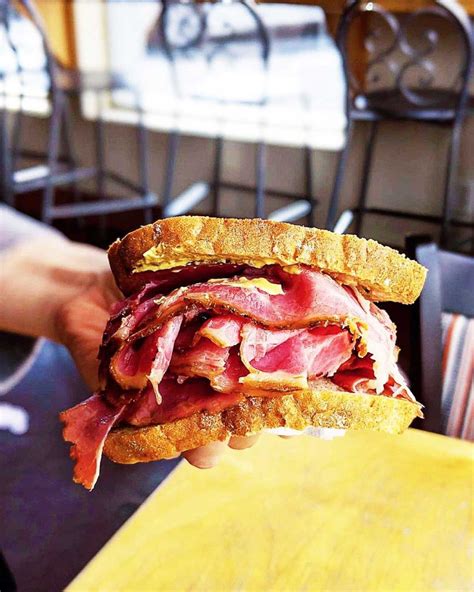
Three deli meats often overlooked—prosciutto, soppressata, and capicola—offer a significant upgrade to the average sandwich, providing distinct flavors and textures that can elevate lunchtime from mundane to gourmet. These Italian specialties, with their nuanced profiles, present opportunities for culinary exploration beyond standard ham and turkey.
Prosciutto, the delicate and thinly sliced dry-cured ham, delivers a salty and slightly sweet flavor, pairing well with both sweet and savory ingredients. Soppressata, a dry-cured salami, offers a more robust and spicy taste, adding a flavorful kick to any sandwich. Capicola, also known as coppa, provides a tender yet firm texture with a balance of spice and richness, rounding out the trio of underappreciated deli options.
Beyond the Ordinary: Exploring Prosciutto, Soppressata, and Capicola
For those seeking to escape the monotony of typical deli meats, prosciutto, soppressata, and capicola represent a gateway to a more flavorful sandwich experience. These meats, while perhaps less familiar to some, offer a depth of taste and texture that can transform a simple meal into a culinary delight.
Prosciutto: The Delicate Delight
Prosciutto, derived from the Italian word for “ham,” is a dry-cured ham that is typically thinly sliced and has a delicate, slightly salty flavor. Its production is a meticulous process, involving careful curing and aging. The ham is first cleaned, salted, and then hung to dry for a period ranging from several months to several years, depending on the desired flavor profile and texture. This aging process concentrates the flavors, resulting in a distinctive taste that is both savory and slightly sweet.
“Prosciutto brings a delicate saltiness and melt-in-your-mouth texture that’s hard to resist,” notes food enthusiasts. This meat is particularly versatile, pairing well with a variety of ingredients. Its delicate flavor complements sweet components like melon or figs, while its saltiness balances richer elements like creamy cheeses.
Prosciutto is commonly used in Italian cuisine, often served as part of an antipasto platter or wrapped around fruits and vegetables. It also shines in sandwiches, where its delicate flavor and texture provide a sophisticated contrast to other ingredients. Pair it with fresh mozzarella, ripe tomatoes, and a drizzle of balsamic glaze for a classic Italian-inspired sandwich. Alternatively, combine it with creamy brie, crisp apples, and a smear of fig jam for a sweet and savory combination.
Soppressata: The Spicy Sensation
Soppressata is a dry-cured salami that originates from southern Italy. Unlike some other salamis, soppressata is typically made with coarsely ground pork, which gives it a more rustic texture and robust flavor. It is also seasoned with a variety of spices, including black pepper, red pepper flakes, and garlic, which contribute to its distinctive spicy kick.
The production of soppressata involves grinding the pork, mixing it with spices, and then stuffing the mixture into a natural casing. The salami is then hung to dry and cure for several weeks or months, allowing the flavors to meld and intensify. The resulting product is a firm, dry salami with a bold and spicy flavor.
“For those who like a little heat, soppressata adds a flavorful kick that’s hard to beat,” experts mention. This salami is perfect for those who enjoy a bit of spice in their sandwiches. Its robust flavor stands up well to other strong ingredients, such as sharp cheeses, tangy pickles, and spicy mustards.
Soppressata can be used in a variety of sandwiches, from simple Italian subs to more complex creations. Combine it with provolone cheese, roasted red peppers, and a drizzle of olive oil for a classic Italian sandwich. Alternatively, pair it with pepper jack cheese, jalapenos, and a smear of chipotle mayo for a spicy and flavorful option. Its bold flavor profile also makes it a great addition to charcuterie boards, pizzas, and pasta dishes.
Capicola: The Balanced Beauty
Capicola, also known as coppa, is a dry-cured pork shoulder that is prized for its tender texture and balanced flavor. It is made from the muscle running from the neck to the fourth or fifth rib of the pig. The production of capicola involves curing the pork shoulder with salt, pepper, and other spices, and then stuffing it into a natural casing. The meat is then hung to dry and cure for several months, allowing the flavors to develop and the texture to become firm yet tender.
Capicola offers a unique combination of spice and richness. Its flavor is less intense than soppressata but more complex than prosciutto, making it a versatile option for a variety of sandwiches. “Capicola offers a great balance of spice and richness, making it a versatile choice for any sandwich,” food critics say.
Capicola can be used in a variety of sandwiches, from classic Italian combinations to more innovative creations. Pair it with provolone cheese, roasted garlic aioli, and arugula for a flavorful and satisfying sandwich. Alternatively, combine it with Swiss cheese, sauerkraut, and Russian dressing for a Reuben-inspired twist. Its balanced flavor also makes it a great addition to charcuterie boards, salads, and pasta dishes.
Elevating Your Sandwich Game: Pairing Suggestions and Tips
To fully appreciate the unique flavors of prosciutto, soppressata, and capicola, consider these pairing suggestions and tips:
- Prosciutto: Pair with sweet fruits like melon or figs, creamy cheeses like mozzarella or brie, and balsamic glaze for a balanced and sophisticated flavor profile. Its delicate flavor is best enjoyed with simple accompaniments that won’t overpower it.
- Soppressata: Combine with sharp cheeses like provolone or pepper jack, tangy pickles or olives, and spicy mustards or aiolis for a bold and flavorful sandwich. Its spicy kick pairs well with ingredients that can stand up to its intensity.
- Capicola: Pair with provolone or Swiss cheese, roasted vegetables like peppers or eggplant, and flavorful sauces like pesto or aioli for a balanced and satisfying sandwich. Its versatility allows it to be used in a variety of flavor combinations.
When selecting these meats, look for high-quality products from reputable delis or specialty stores. Freshly sliced meats will generally have a better flavor and texture than pre-packaged options. Also, consider the salt content of each meat and adjust your other ingredients accordingly. If the meat is particularly salty, you may want to use less salt in your sauces or spreads.
Expanding Your Culinary Horizons
By incorporating prosciutto, soppressata, and capicola into your sandwich repertoire, you can expand your culinary horizons and discover new flavor combinations. These meats offer a welcome departure from the ordinary, providing a taste of Italy and a touch of sophistication to your lunchtime routine. Don’t be afraid to experiment with different pairings and create your own signature sandwiches featuring these underappreciated deli gems. The possibilities are endless, and the rewards are delicious.
The Art of Curing: A Deeper Look
The curing process is fundamental to the distinctive flavors and textures of prosciutto, soppressata, and capicola. Curing involves preserving meat through the use of salt, nitrates, and nitrites, which inhibit the growth of bacteria and help to draw out moisture. This process not only extends the shelf life of the meat but also contributes to its unique taste and texture.
In the case of prosciutto, the curing process is particularly crucial. The ham is first covered in salt, which draws out moisture and prevents spoilage. It is then hung to dry in a controlled environment, where the temperature and humidity are carefully monitored. This drying process can take several months or even years, depending on the desired flavor and texture. During this time, enzymes break down the proteins in the meat, resulting in a tender and flavorful product.
Soppressata and capicola also undergo a curing process, although it is slightly different from that of prosciutto. These meats are typically cured with a combination of salt, nitrates, nitrites, and spices. The spices add flavor and also help to inhibit the growth of bacteria. After being cured, the meats are stuffed into natural casings and hung to dry. The drying process can take several weeks or months, depending on the desired flavor and texture.
The art of curing is a time-honored tradition that has been passed down through generations of Italian meat producers. It requires a deep understanding of the science of meat preservation, as well as a keen eye for detail. The result is a range of delicious and distinctive meats that are enjoyed around the world.
Regional Variations: A Taste of Italy
Prosciutto, soppressata, and capicola are not just generic deli meats; they are regional specialties with distinct variations depending on where they are produced in Italy. Each region has its own unique curing techniques, spice blends, and aging processes, resulting in a diverse range of flavors and textures.
For example, Prosciutto di Parma, from the Emilia-Romagna region, is known for its delicate sweetness and melt-in-your-mouth texture. It is made using only traditional methods and is aged for a minimum of 12 months. Prosciutto di San Daniele, from the Friuli Venezia Giulia region, is another highly prized variety, known for its nutty flavor and delicate aroma.
Soppressata also has regional variations. Soppressata di Calabria, from the Calabria region, is known for its spicy flavor and coarse texture. It is made with pork, red pepper flakes, and other spices. Soppressata Toscana, from the Tuscany region, is a milder variety, made with pork, black pepper, and garlic.
Capicola also has regional variations. Capocollo di Calabria is a Protected Designation of Origin (PDO) product, meaning it can only be produced in the Calabria region using traditional methods. It is known for its balanced flavor and tender texture.
Exploring these regional variations can be a culinary adventure in itself. Each variety offers a unique taste of Italy, reflecting the traditions and flavors of its region of origin.
Health Considerations: Moderation is Key
While prosciutto, soppressata, and capicola can add flavor and variety to your diet, it’s important to consume them in moderation. These meats are typically high in sodium and saturated fat, and some varieties may also contain nitrates and nitrites.
Sodium is an essential nutrient, but excessive intake can lead to high blood pressure and other health problems. Saturated fat can raise cholesterol levels and increase the risk of heart disease. Nitrates and nitrites are used as preservatives in cured meats, but they can also be converted into potentially harmful compounds in the body.
For these reasons, it’s best to enjoy these meats as an occasional treat rather than a dietary staple. Choose lean varieties when possible, and be mindful of portion sizes. Also, consider balancing your intake of cured meats with plenty of fruits, vegetables, and whole grains.
Individuals with certain health conditions, such as high blood pressure or heart disease, may need to limit their intake of cured meats even further. Consult with a healthcare professional or registered dietitian for personalized dietary advice.
Beyond Sandwiches: Creative Culinary Uses
Prosciutto, soppressata, and capicola are not just for sandwiches; they can be used in a variety of creative culinary applications. Their unique flavors and textures can add depth and complexity to a wide range of dishes.
Here are some ideas for incorporating these meats into your cooking:
- Charcuterie Boards: Prosciutto, soppressata, and capicola are essential components of any well-curated charcuterie board. Pair them with a variety of cheeses, olives, fruits, and nuts for a flavorful and visually appealing appetizer.
- Pizzas: Add slices of prosciutto, soppressata, or capicola to your favorite pizza for a burst of flavor. They pair well with a variety of toppings, such as mozzarella, mushrooms, and roasted vegetables.
- Pasta Dishes: Incorporate these meats into your pasta sauces for added depth and complexity. Sauté diced prosciutto, soppressata, or capicola with garlic, onions, and tomatoes for a flavorful base for your sauce.
- Salads: Add crispy prosciutto, soppressata, or capicola to your salads for a salty and savory crunch. They pair well with a variety of greens, vegetables, and dressings.
- Frittatas and Quiches: Incorporate diced prosciutto, soppressata, or capicola into your frittatas and quiches for a flavorful and protein-rich breakfast or brunch dish.
- Stuffed Vegetables: Use these meats as a filling for stuffed vegetables, such as peppers, tomatoes, or zucchini. Combine them with rice, herbs, and cheese for a hearty and flavorful meal.
- Wraps and Roll-Ups: Use thin slices of prosciutto, soppressata, or capicola to wrap around vegetables, cheeses, or fruits for a quick and easy appetizer or snack.
The possibilities are endless when it comes to incorporating these meats into your cooking. Experiment with different combinations and discover your own favorite ways to enjoy them.
The Economic Impact of Italian Deli Meats
The production and sale of Italian deli meats like prosciutto, soppressata, and capicola have a significant economic impact, both in Italy and in countries that import these products. The industry supports thousands of jobs, from farmers and meat processors to distributors and retailers.
In Italy, the production of these meats is a traditional craft that has been passed down through generations. Many small, family-owned businesses are involved in the production process, contributing to the local economy and preserving cultural heritage.
The export of Italian deli meats also generates significant revenue for the country. These products are highly sought after around the world, particularly in countries with large Italian diaspora communities.
In the United States, the import and sale of Italian deli meats support a thriving industry. Many delis, restaurants, and specialty food stores carry these products, providing consumers with a taste of Italy. The industry also provides jobs for importers, distributors, and retailers.
The economic impact of Italian deli meats extends beyond the food industry. The tourism industry also benefits from the popularity of these products. Many tourists visit Italy specifically to sample the local cuisine, including prosciutto, soppressata, and capicola.
The Future of Deli Meats: Trends and Innovations
The deli meat industry is constantly evolving, with new trends and innovations emerging all the time. Consumers are increasingly demanding high-quality, sustainably produced meats, and producers are responding by developing new and innovative products.
One trend is the growing popularity of artisanal and small-batch deli meats. Consumers are seeking out unique and flavorful products that are made using traditional methods. This trend is driving demand for meats like prosciutto, soppressata, and capicola, which are often made by small, family-owned businesses.
Another trend is the increasing focus on sustainability. Consumers are concerned about the environmental impact of meat production and are seeking out products that are made using sustainable farming practices. This trend is driving demand for meats that are raised without antibiotics or hormones and that are sourced from farms that prioritize animal welfare and environmental stewardship.
Innovations in packaging and processing are also shaping the future of the deli meat industry. New packaging technologies are helping to extend the shelf life of deli meats while preserving their flavor and texture. Advances in processing techniques are allowing producers to create new and innovative products, such as pre-sliced and pre-packaged deli meats.
The future of the deli meat industry is likely to be characterized by a continued focus on quality, sustainability, and innovation. Consumers will continue to demand high-quality, flavorful products that are made using sustainable practices. Producers will respond by developing new and innovative products that meet these demands.
Frequently Asked Questions (FAQ)
-
What is the difference between prosciutto, soppressata, and capicola?
- Prosciutto is a dry-cured ham that is thinly sliced and has a delicate, slightly salty flavor. Soppressata is a dry-cured salami that is made with coarsely ground pork and seasoned with spices, giving it a spicy kick. Capicola (coppa) is a dry-cured pork shoulder that is prized for its tender texture and balanced flavor, offering a combination of spice and richness.
-
How should I store prosciutto, soppressata, and capicola?
- Once opened, these deli meats should be stored in the refrigerator, tightly wrapped in plastic wrap or in an airtight container. It’s best to consume them within a few days to maintain their flavor and texture. Unopened, follow the storage instructions on the package.
-
Are prosciutto, soppressata, and capicola healthy?
- These meats can be part of a balanced diet when consumed in moderation. They are high in protein but also contain sodium and saturated fat. Some varieties may contain nitrates or nitrites. It’s important to be mindful of portion sizes and to choose lean varieties when possible.
-
Can I freeze prosciutto, soppressata, and capicola?
- Freezing these meats is not generally recommended as it can alter their texture and flavor. Prosciutto, in particular, can become watery after thawing. Soppressata and capicola may also lose some of their texture and flavor, but if you must freeze them, wrap them tightly in plastic wrap and then in a freezer bag.
-
What are some good pairings for prosciutto, soppressata, and capicola?
- Prosciutto pairs well with sweet fruits like melon or figs, creamy cheeses like mozzarella or brie, and balsamic glaze. Soppressata is great with sharp cheeses like provolone or pepper jack, tangy pickles or olives, and spicy mustards or aiolis. Capicola complements provolone or Swiss cheese, roasted vegetables like peppers or eggplant, and flavorful sauces like pesto or aioli.









